A Private Tour in North Norfolk today. It was a lovely sunny spring day, warm in the sun but with a distinct chill still in the wind.
We met up at Titchwell, at Briarfields Hotel, just in time to see a Barn Owl perched on a post at the back of the field behind. It then took off, did a quick circuit of the field and disappeared away through the hedge. A couple of Marsh Harriers drifted over on their way inland.
Our journey took us east first, along the coast road. We hadn’t gone far when we spotted another Barn Owl out quartering over a rough grassy meadow. As we stopped to look at it, a Common Buzzard appeared from the trees nearby and stooped down towards it. The Barn Owl took evasive action, but the Buzzard set off after it and chased it away over the field until it disappeared through the trees the other side. Such are the perils of being out hunting during the day!
Our first stop was at Burnham Overy Staithe. We could hear Oystercatchers calling noisily as we got out of the car and a group of three were piping away to each other on the edge of the channel, with their necks out and bills pointing at the ground, displaying. As we set out along the seawall, a Chiffchaff was singing from the bushes – the first of several we heard on walk out. Typically our earliest returning migrant warbler, there are lots of them back for the summer now.
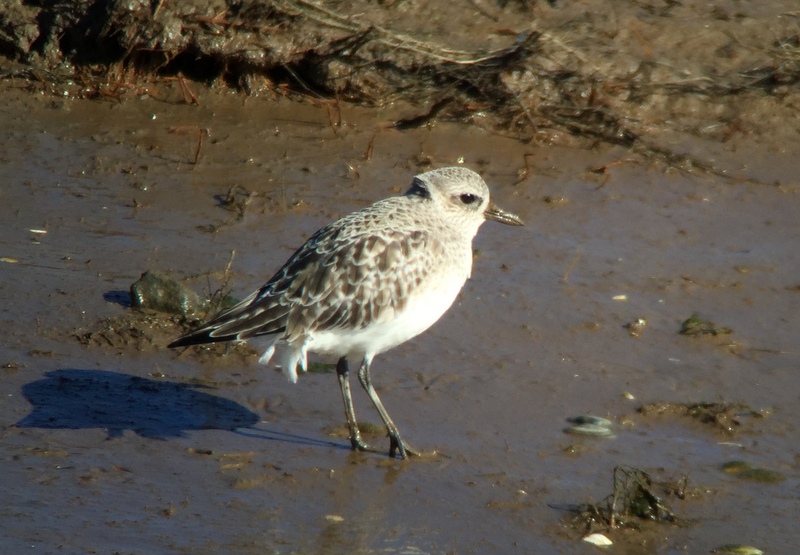 Grey Plover – several were in the harbour
Grey Plover – several were in the harbour
There were lots of other waders in the harbour as we walked out. We stopped to look at a Grey Plover, feeding on the near side of the channel, close to us. A couple of pairs of Avocet were further away, over the far side. A small group of Bar-tailed Godwits were on a sandbar out in the middle of the harbour. In contrast, all but one of the Black-tailed Godwits were on the other side of the seawall, mostly sleeping on the edge of the pools on the grazing marshes.
The tide was rising, and the mud was gradually disappearing. As it did so, more waders started to gather on a small spit close to the bank. A little group of Knot flew in first, smallish and dumpy. They were promptly joined by a few Dunlin, smaller still and slightly more contrasting, darker grey above and whiter below – a nice comparison to see them side by side with the Knot. Then the Bar-tailed Godwits flew in too – we had a much better view of them up close. A Turnstone and a single Oystercatcher rounded off the little gathering nicely.
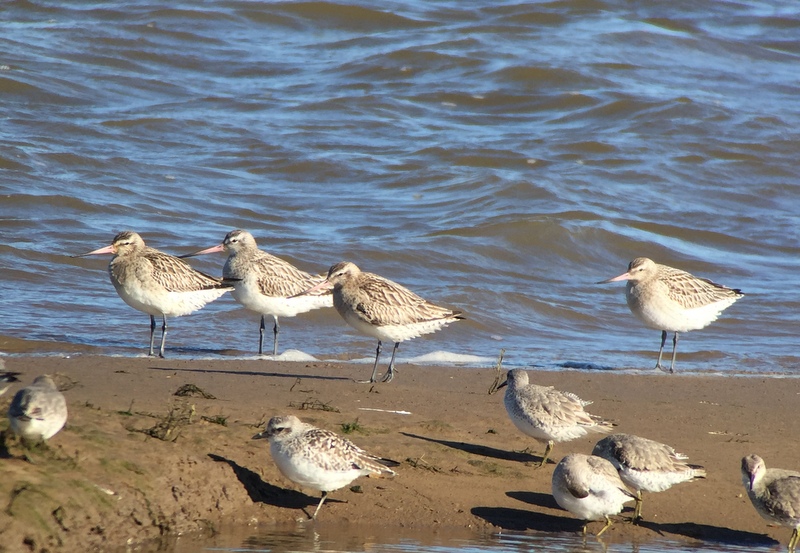 Bar-tailed Godwits, Knot & Grey Plover – gathering on the rising tide
Bar-tailed Godwits, Knot & Grey Plover – gathering on the rising tide
There were several small groups of Brent Geese around the harbour and one flew in and landed by the waders, so that we could get a good look at them through the scope. A bigger group of Brent Geese was further out on the saltmarsh, over towards the dunes. One stood out as slightly darker than the majority, which are almost all Russian Dark-bellied Brent Geese, with a bolder white flank patch and collar. This was the regular Black Brant x Dark-bellied Brent hybrid, which can normally be found around the fields here over the winter. Although at this time of year, it prefers to be feeding out on the saltmarsh. Unlike the Brents which are still around in good numbers, almost all the Pink-footed Geese which spend the winter here have left already, but we did manage to find a flock of about 30 still out on the grazing marshes.
 Brent Geese – still good numbers here still for now
Brent Geese – still good numbers here still for now
We could hear Bearded Tits calling out in the reeds by the seawall. Following the sound, we got a quick glimpse of two of them in flight, but it seemed like that might be the best we could hope for today. Bearded Tits don’t like the wind, and it felt like it was a bit too breezy. A Spoonbill briefly in flight over the salt marsh the other side of the harbour was similarly frustrating, dropping down again into a channel before anyone could get onto it. At least the raptors were more amenable. There were lots up in the air this morning – plenty of Buzzards and Marsh Harriers, and a single Red Kite circling over the dunes.
Out at the boardwalk, we turned east and headed into the dunes. We hadn’t gone very far, when we found just what we were looking for. A female Wheatear had found somewhere out of the wind, in a sheltered dune slack. She was very active, moving all the time, hopping round picking at the ground for insects, looking into rabbit burrows (though they don’t nest here). At one point she flew across, flashing her white tail base.
 Wheatear – this female was in the dunes today
Wheatear – this female was in the dunes today
We watched her for a while and had just decided to carry on further into the dunes to see if we could find a male Wheatear too when one obligingly appeared for us. He flew in over the dunes and landed on the ground near the female. She seemed to take offense and tried to chase him off a couple of times, but he persisted and they established what appeared to be an uneasy truce, with him feeding on one side of the dunes slack and her on the other. The male Wheatear was looking particularly smart in the spring sunshine, cleaner grey above and whiter below than the female, with a brighter peachy wash on the throat and upper breast, blacker wings and a striking black bandit mask.
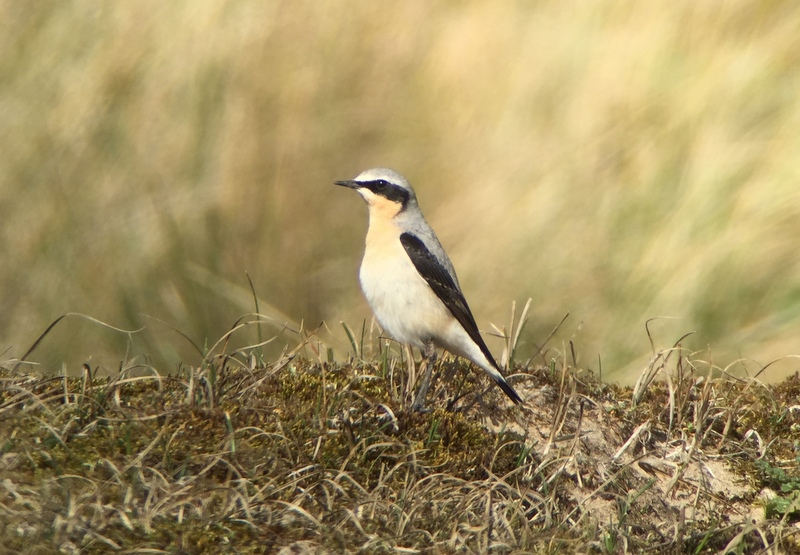 Wheatear – this smart male flew in to join the female
Wheatear – this smart male flew in to join the female
Wheatears are mainly migrants in Norfolk, and one of the earliest of the trans-Saharan migrants to reappear in the spring. They used to breed commonly on the grass heaths and rabbit warrens here, but now appear to be all but extinct as a breeding bird – although they are still common on the uplands of northern and western Britain. It is a real sign of spring here when the Wheatears are moving through – and they are such cracking birds too.
It was rather busy in the dunes, with lots of walkers and dog-walkers, but we carried on a bit further to see if we could find anything else. Two more Wheatears disappeared over the dunes towards the grazing marshes. With all the disturbance here today, we decided to walk back. Scanning from back on the boardwalk, we could see yet more Wheatears in the dunes out towards Gun Hill. There had clearly been a small fall of them this morning.
Back at the reeds, we stopped to listen. We could hear the Bearded Tits again, their distinctive ‘pinging’ call, but this time when they flew they landed on the edge of a small pool near the front. They were low down in the reeds, but we could see them here. We got them in the scope, great views – at least two browner females and a smart grey-headed male with black moustache. There were possibly more, but it was hard to keep track as they kept moving, working their way round the edge of the pool, before they all disappeared deeper into the reeds. It seemed like we might be out of luck with Bearded Tits today, given the wind and our fleeting views on the walk out, so this was a real result to see them so well, especially so given it was a particularly wanted target bird.
As we continued on along the path, we could hear a Marsh Harrier calling and turned to see it displaying high overhead – a series of swoops and turns. Then a Peregrine swept across in front of us and out to the edge of harbour, before circling back over our heads. We could see it was a young bird – heavily streaked not barred below. We watched it disappear back towards Holkham. A little further along, another Peregrine zoomed past and out across the saltmarsh – a closer look revealed this one was different, an adult.
 Peregrine – a juvenile circled overhead
Peregrine – a juvenile circled overhead
Next, we made our way back along the coast to the reserve at Titchwell. As we arrived, a Red Kite drifted over the trees and continued on its way west – there seems to be a regular passage of Red Kites along the coast here in early spring these days. After lunch, we headed out to explore the reserve afterwards. Several Siskins were coming and going around the feeders in front of the visitor centre.
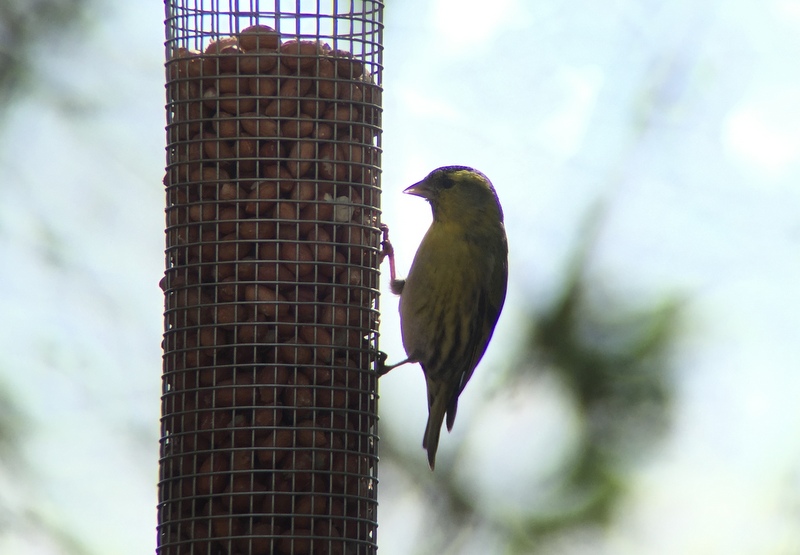 Siskin – on the feeders at Titchwell
Siskin – on the feeders at Titchwell
A quick stop for a coffee was required and while we were resting at one of the picnic tables, a very tame Song Thrush came hopping out of the trees and around the edge by the tables.
 Song Thrush – came out to the picnic tables
Song Thrush – came out to the picnic tables
On the other side of the visitor centre, the feeders looked rather quiet at first, apart from a couple of Chaffinches. But a careful scan around the bushes just behind revealed a female Brambling, lurking in amongst the branches. Then,while we were watching it, a bright orange breasted male Brambling flew in to the feeders. We could see his head now getting increasingly black, though still speckled with brown. It should only be a matter of time now before the Bramblings are on their way back across the North Sea to Scandinavia.
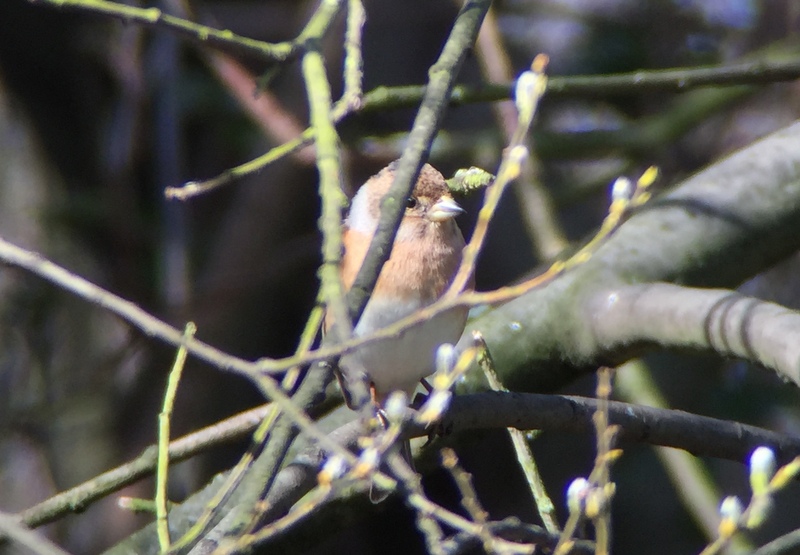 Brambling – the female was hiding…
Brambling – the female was hiding…
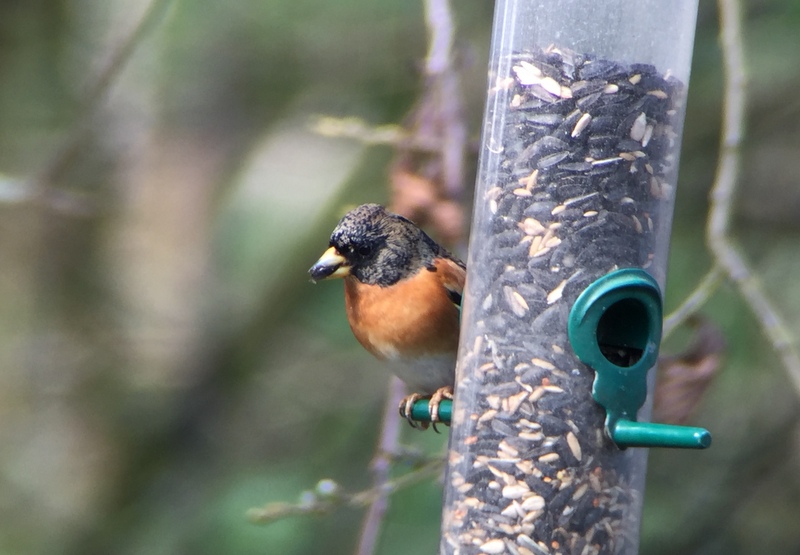 Brambling – …but the brighter orange male came out on the feeders
Brambling – …but the brighter orange male came out on the feeders
Out on the main path, we had a look for the Water Rail in the ditch alongside. We had just stopped to talk to the warden when it crept out of the undergrowth. We had a great view of it as it fed on the wet mud, before it scurried further along the stream, where it started squealing.
 Water Rail – still in the ditch, as usual, for the time being
Water Rail – still in the ditch, as usual, for the time being
The grazing meadow ‘pool’ remains dry, but for a few puddles. This has been much to the liking of the Water Pipits and they are still present for now, although they should be on their way back to the mountains of central Europe soon. They are now coming into summer plumage – the black streaks are mostly gone from their breasts and in their place is a delightful pink flush. There were at least three today, the first we found was at the back, along the edge of the reeds. However, one Water Pipit was much closer, preening in the cut reeds right at the front for a while.
A Little Ringed Plover had also been reported on here earlier in the morning, but no one seemed to have seen it since. A careful scan revealed it lurking out on the mud, right over in the far corner. Little Ringed Plovers are summer visitors here, and this is another early returning migrant.
We stopped opposite the reedbed pool and scanned the reeds. A Cetti’s Warbler sang loudly from deep in the brambles in front of us. We could hear Bearded Tits ‘pinging’ further out in the reeds, and got the usual glimpse of one as it dropped down out of sight – thankfully we had seen them well earlier in the day. The Marsh Harriers put on a much better display. A nice grey male circled over the reeds in front of us, but when it dropped down to the ground a second darker male came plummeting out of the sky and straight for it. The first male took off and the two of them stooped at each other and talon-grappled, before circling round each other over the reeds.
 Marsh Harrier – one of two males which had a dispute over the reedbed
Marsh Harrier – one of two males which had a dispute over the reedbed
Out on the reedbed pool, we could see a few Common Pochard and Tufted Duck diving towards the back. A pair of Red-crested Pochard were down at the front, although a pair of the local Mallard tried to chase them off. The drake Red-crested Pochards are looking particularly striking now, with their bright orange hairdos and coral red bills.
 Red-crested Pochard – the drakes are looking very striking now
Red-crested Pochard – the drakes are looking very striking now
The freshmarsh is very full of water at the moment – apparently a ploy to try to encourage the Avocets to nest on the newly fenced islands, although they almost all seem to have gone elsewhere at the moment. There were plenty of Gadwall enjoying all the water, but very little else on here today, so we didn’t stop in Island Hide.
As we walked along the main path, we could hear Mediterranean Gulls calling and a pair circled down and landed in the shallow water next to one of the few remaining tiny unfenced islands. We got them in the scope, two smart adults, white ‘eyelids’ contrasting with jet black hoods, deep red bills and pure white wingtips. They had dropped in for a preen and quickly got down to work.
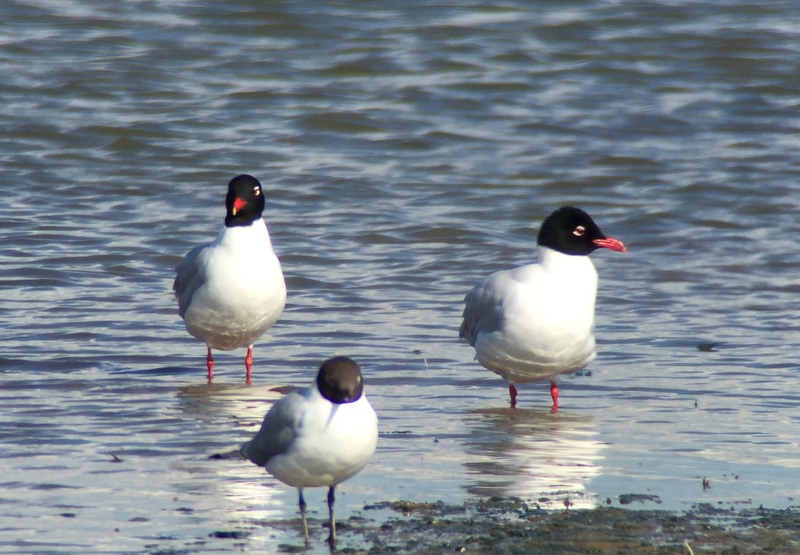 Mediterranean Gulls – this pair dropped down onto the freshmarsh
Mediterranean Gulls – this pair dropped down onto the freshmarsh
There was not so much to see on the Volunteer Marsh either today – a few Redshank, a couple of Shelduck and a single Grey Plover. A couple of pairs of Teal were feeding noisily on the mud by the path. There were a few more birds along the channel at the far end – several Curlew and Black-tailed Godwits. A Redshank down at the front was doing very well, greedily gobbling down long worms.
All the action was out on the tidal pools. This is where most of the Avocets have gone to feed, with all the water on the freshmarsh. Even here they are struggling a bit, up to their bellies in water, trying to sweep their bills through the top of the mud. The club-footed Bar-tailed Godwit was on here too – it is obviously managing to feed successfully, but was struggling to preen and kept overbalancing. There were several Black-tailed Godwits too, giving us a nice side by side comparison of the two, although the Black-tailed Godwits are increasingly sporting bright orange summer plumage feathers now. The Bar-tailed Godwits appear to be a bit behind.
 Avocet – not easy feeding in the deep water
Avocet – not easy feeding in the deep water
Out at the beach, the tide was going out. There was a nice group of about twenty or so Common Scoter just offshore, close enough for a nice view through the scope, a mixture of pale-cheeked browner females and jet black males. In the sunshine, the yellow stripe down the top of the bill on the drakes really caught the light. A Great Crested Grebe flew in and landed just behind them, but was hard to follow as it dived continually. Much further out, a larger flock of several hundred Common Scoter looked a bit like an oil slick smeared across the water.
There were a few waders out on the edge of the sea and in amongst them we picked up three small birds, bright silvery grey and running around on the sand. They were Sanderlings, the clockwork toys of the beach, and a nice addition to the day’s list.
Then it was time to walk back. A Black-tailed Godwit had now flown in to the front of the Volunteer Marsh and was feeding on the mud right by the main path. We had great views of it, pulling long worms and other smaller invertebrates out from the mud (it was hard to see what they were, covered in brown, sticky stuff!). It was in the process of moulting to summer plumage – with patchy orange around the face and breast and several black and rusty feathers showing in its upperparts.
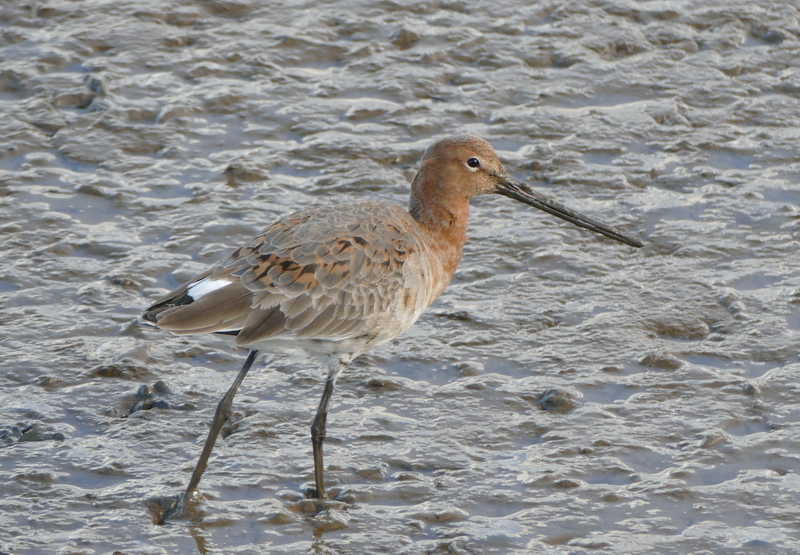 Black-tailed Godwit – moulting into summer plumage
Black-tailed Godwit – moulting into summer plumage
As we made our way back to the visitor centre, we could hear a Water Rail calling from the ditch and as we approached we could see one down in the water at the bottom, in much the same places as we had left it earlier. Then a second Water Rail appeared, running along the stream from the opposite direction. It had its head and neck outstretched and its tail fanned – it looked like there might be a territorial dispute coming at first. Then the first Water Rail ran out onto a small patch of mud on the edge and crouched, back on, at which point the second bird ran straight to it, mounted and started to mate with it.
Mating is very seldom observed in Water Rails, which tend to be very secretive and hide in reedbeds in the summer months. Indeed, it appears to be all but undescribed in the literature, which means we were extremely fortunate to witness this behaviour! The aftermath was not much to write home about – the female walked into the stream and started to bathe, the male preened for a few seconds on the mud, then walked up the bank and out into the field beyond.
 Water Rails – very rarely seen mating
Water Rails – very rarely seen mating
It was time for us to leave too. A very interesting note to end on today!
















